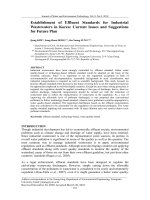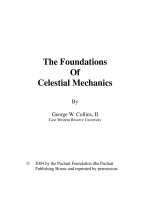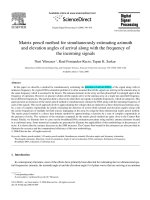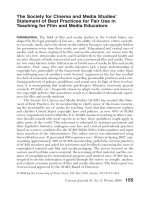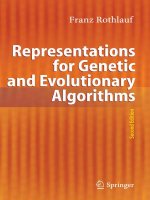G w stewart matrix algorithms society for industrial and applied mathematics (1998)
Bạn đang xem bản rút gọn của tài liệu. Xem và tải ngay bản đầy đủ của tài liệu tại đây (38.9 MB, 479 trang )
www.pdfgrip.com
Matrix
Algorithms
www.pdfgrip.com
This page intentionally left blank
www.pdfgrip.com
Matrix
Algorithms
Volume I:Basic Decompositions
G. W.
Stewart
University of Maryland
College Park, Maryland
siam
Society for Industrial and Applied Mathematics
Philadelphia
www.pdfgrip.com
Copyright ©1998 by the Society for Industrial and Applied Mathematics.
1098765432 1
All rights reserved. Printed in the United States of America. No part of this book may be reproduced,
stored, or transmitted in any manner without the written permission of the publisher. For information, write
to the Society for Industrial and Applied Mathematics, 3600 University City Science Center, Philadelphia,
PA 19104-2688.
Library of Congress Cataloging-in-Publication Data
Stewart, G. W. (Gilbert W.)
Matrix algorithms / G. W. Stewart.
p. cm.
Includes bibliographical references and index.
Contents: v. 1. Basic decompositions
ISBN 0-89871-414-1 (v. 1 : pbk.)
1. Matrices. I. Title.
QA188.S714 1998
512.9'434-dc21
98-22445
0-89871-414-1 (Volume I)
0-89871-418-4 (set)
siam is a registered trademark.
www.pdfgrip.com
CONTENTS
Algorithms
xiii
Notation
xv
Preface
xvii
1 Matrices, Algebra, and Analysis
1 Vectors
1.1 Scalars
Real and complex numbers. Sets and Minkowski sums.
1.2 Vectors
1.3 Operations with vectors and scalars
1.4 Notes and references
Representing vectors and scalars. The scalar product. Function
spaces.
2 Matrices
2.1 Matrices
2.2 Some special matrices
Familiar characters. Patterned matrices.
2.3 Operations with matrices
The scalar-matrix product and the matrix sum. The matrix
product. The transpose and symmetry. The trace and the
determinant.
2.4 Submatrices and partitioning
Submatrices. Partitions. Northwest indexing. Partitioning and
matrix operations. Block forms.
2.5 Some elementary constructions
Inner products. Outer products. Linear combinations. Column
and row scaling. Permuting rows and columns. Undoing a
permutation. Crossing a matrix. Extracting and inserting
submatrices.
2.6 LU decompositions
2.7 Homogeneous equations
v
1
2
2
3
5
7
7
8
9
13
17
21
23
25
www.pdfgrip.com
vi
CONTENTS
2.8 Notes and references
Indexing conventions. Hyphens and other considerations.
Nomenclature for triangular matrices. Complex symmetric
matrices. Determinants. Partitioned matrices. The
LU decomposition.
3 Linear Algebra
3.1 Subspaces, linear independence, and bases
Subspaces. Linear independence. Bases. Dimension.
3.2 Rank and nullity
A full-rank factorization. Rank and nullity.
3.3 Nonsingularity and inverses
Linear systems and nonsingularity. Nonsingularity and inverses.
3.4 Change of bases and linear transformations
Change of basis. Linear transformations and matrices.
3.5 Notes and references
Linear algebra. Full-rank factorizations.
4 Analysis
4.1 Norms
Componentwise inequalities and absolute values. Vector norms.
Norms and convergence. Matrix norms and consistency. Operator
norms. Absolute norms. Perturbations of the identity. The
Neumann series.
4.2 Orthogonality and projections
Orthogonality. The QR factorization and orthonormal bases.
Orthogonal projections.
4.3 The singular value decomposition
Existence. Uniqueness. Unitary equivalence. Weyl's theorem and
the min-max characterization. The perturbation of singular
values. Low-rank approximations.
4.4 The spectral decomposition
4.5 Canonical angles and the CS decomposition
Canonical angles between subspaces. The CS decomposition.
4.6 Notes and references
Vector and matrix norms. Inverses and the Neumann series. The
QR factorization. Projections. The singular value decomposition.
The spectral decomposition. Canonical angles and the
CS decomposition.
5 Addenda
5.1 Historical
On the word matrix. History.
5.2 General references
Linear algebra and matrix theory. Classics of matrix
26
28
28
33
36
39
42
42
42
55
61
70
73
75
77
77
78
www.pdfgrip.com
CONTENTS
vii
computations. Textbooks. Special topics. Software. Historical
sources.
2 Matrices and Machines
1 Pseudocode
1.1 Generalities
1.2 Control statements
The if statement. The for statement. The while statement.
Leaving and iterating control statements. The goto statement.
1.3 Functions
1.4 Notes and references
Programming languages. Pseudocode.
2 Triangular Systems
2.1 The solution of a lower triangular system
Existence of solutions. The forward substitution algorithm.
Overwriting the right-hand side.
2.2 Recursive derivation
2.3 A "new" algorithm
2.4 The transposed system
2.5 Bidiagonal matrices
2.6 Inversion of triangular matrices
2.7 Operation counts
Bidiagonal systems. Full triangular systems. General
observations on operations counts. Inversion of a triangular
matrix. More observations on operation counts.
2.8 BLAS for triangular systems
2.9 Notes and references
Historical. Recursion. Operation counts. Basic linear algebra
subprograms (BLAS).
3 Matrices in Memory
3.1 Memory, arrays, and matrices
Memory. Storage of arrays. Strides.
3.2 Matrices in memory
Array references in matrix computations. Optimization and the
BLAS. Economizing memory—Packed storage.
3.3 Hierarchical memories
Virtual memory and locality of reference. Cache memory. A
model algorithm. Row and column orientation. Level-two BLAS.
Keeping data in registers. Blocking and the level-three BLAS.
3.4 Notes and references
The storage of arrays. Strides and interleaved memory. The
BLAS. Virtual memory. Cache memory. Large memories and
matrix problems. Blocking.
81
82
82
83
85
86
87
87
89
90
92
92
93
94
99
100
101
102
104
109
119
www.pdfgrip.com
viii
CONTENTS
4 Rounding Error
4.1 Absolute and relative error
Absolute error. Relative error.
4.2 Floating-point numbers and arithmetic
Floating-point numbers. The IEEE standard. Rounding error.
Floating-point arithmetic.
4.3 Computing a sum: Stability and condition
A backward error analysis. Backward stability. Weak stability.
Condition numbers. Reenter rounding error.
4.4 Cancellation
4.5 Exponent exceptions
Overflow. Avoiding overflows. Exceptions in the IEEE standard.
4.6 Notes and references
General references. Relative error and precision. Nomenclature
for floating-point numbers. The rounding unit. Nonstandard
floating-point arithmetic. Backward rounding-error analysis.
Stability. Condition numbers. Cancellation. Exponent exceptions.
3 Gaussian Elimination
1 Gaussian Elimination
1.1 Four faces of Gaussian elimination
Gauss's elimination. Gaussian elimination and elementary row
operations. Gaussian elimination as a transformation to triangular
form. Gaussian elimination and the LU decomposition.
1.2 Classical Gaussian elimination
The algorithm. Analysis of classical Gaussian elimination. LU
decompositions. Block elimination. Schur complements.
1.3 Pivoting
Gaussian elimination with pivoting. Generalities on pivoting.
Gaussian elimination with partial pivoting.
1.4 Variations on Gaussian elimination
Sherman's march. Pickett's charge. Grout's method. Advantages
over classical Gaussian elimination.
1.5 Linear systems, determinants, and inverses
Solution of linear systems. Determinants. Matrix inversion.
1.6 Notes and references
Decompositions and matrix computations. Classical Gaussian
elimination. Elementary matrix. The LU decomposition. Block
LU decompositions and Schur complements. Block algorithms
and blocked algorithms. Pivoting. Exotic orders of elimination.
Gaussian elimination and its variants. Matrix inversion.
Augmented matrices. Gauss-Jordan elimination.
2 A Most Versatile Algorithm
121
121
124
129
136
138
141
147
148
148
153
165
169
174
180
185
www.pdfgrip.com
CONTENTS
2.1 Positive definite matrices
Positive definite matrices. The Cholesky decomposition. The
Cholesky algorithm.
2.2 Symmetric indefinite matrices
2.3 Hessenberg and tridiagonal matrices
Structure and elimination. Hessenberg matrices. Tridiagonal
matrices.
2.4 Band matrices
2.5 Notes and references
Positive definite matrices. Symmetric indefinite systems. Band
matrices.
3 The Sensitivity of Linear Systems
3.1 Normwise bounds
The basic perturbation theorem. Normwise relative error and the
condition number. Perturbations of the right-hand side. Artificial
ill-conditioning.
3.2 Componentwise bounds
3.3 Backward perturbation theory
Normwise backward error bounds. Componentwise backward
error bounds.
3.4 Iterative refinement
3.5 Notes and references
General references. Normwise perturbation bounds. Artificial
ill-conditioning. Componentwise bounds. Backward perturbation
theory. Iterative refinement.
4 The Effects of Rounding Error
4.1 Error analysis of triangular systems
The results of the error analysis.
4.2 The accuracy of the computed solutions
The residual vector.
4.3 Error analysis of Gaussian elimination
The error analysis. The condition of the triangular factors. The
solution of linear systems. Matrix inversion.
4.4 Pivoting and scaling
On scaling and growth factors. Partial and complete pivoting.
Matrices that do not require pivoting. Scaling.
4.5 Iterative refinement
A general analysis. Double-precision computation of the residual.
Single-precision computation of the residual. Assessment of
iterative refinement.
4.6 Notes and references
General references. Historical. The error analyses. Condition of
ix
185
190
194
202
207
208
209
217
219
221
224
225
226
227
229
235
242
245
www.pdfgrip.com
x
CONTENTS
the L- and U-factors. Inverses. Growth factors. Scaling. Iterative
refinement.
4 The QR Decomposition and Least Squares
1 The QR Decomposition
1.1 Basics
Existence and uniqueness. Projections and the pseudoinverse.
The partitioned factorization. Relation to the singular value
decomposition.
1.2 Householder triangularization
Householder transformations. Householder triangularization.
Computation of projections. Numerical stability. Graded
matrices. Blocked reduction.
1.3 Triangularization by plane rotations
Plane rotations. Reduction of a Hessenberg matrix. Numerical
properties.
1.4 The Gram—Schmidt algorithm
The classical and modified Gram-Schmidt algorithms. Modified
Gram—Schmidt and Householder triangularization. Error analysis
of the modified Gram-Schmidt algorithm. Loss of orthogonality.
Reorthogonalization.
1.5 Notes and references
General references. The QR decomposition. The pseudoinverse.
Householder triangularization. Rounding-error analysis. Blocked
reduction. Plane rotations. Storing rotations. Fast rotations. The
Gram—Schmidt algorithm. Reorthogonalization.
2 Linear Least Squares
2.1 The QR approach
Least squares via the QR decomposition. Least squares via the
QR factorization. Least squares via the modified Gram-Schmidt
algorithm.
2.2 The normal and seminormal equations
The normal equations. Forming cross-product matrices. The
augmented cross-product matrix. The instability of cross-product
matrices. The seminormal equations.
2.3 Perturbation theory and its consequences
The effects of rounding error. Perturbation of the normal
equations. The perturbation of pseudoinverses. The perturbation
of least squares solutions. Accuracy of computed solutions.
Comparisons.
2.4 Least squares with linear constraints
The null-space method. The method of elimination. The
weighting method.
249
250
250
254
270
277
288
292
293
298
305
312
www.pdfgrip.com
CONTENTS
2.5 Iterative refinement
2.6 Notes and references
Historical. The QR approach. Gram-Schmidt and least squares.
The augmented least squares matrix. The normal equations. The
seminormal equations. Rounding-error analyses. Perturbation
analysis. Constrained least squares. Iterative refinement.
3 Updating
3.1 Updating inverses
Woodbury's formula. The sweep operator.
3.2 Moving columns
A general approach. Interchanging columns.
3.3 Removing a column
3.4 Appending columns
Appending a column to a QR decomposition. Appending a
column to a QR factorization.
3.5 Appending a row
3.6 Removing a row
Removing a row from a QR decomposition. Removing a row
from a QR factorization. Removing a row from an R-factor
(Cholesky downdating). Downdating a vector.
3.7 General rank-one updates
Updating a factorization. Updating a decomposition.
3.8 Numerical properties
Updating. Downdating.
3.9 Notes and references
Historical. Updating inverses. Updating. Exponential
windowing. Cholesky downdating. Downdating a vector.
5 Rank-Reducing Decompositions
1 Fundamental Subspaces and Rank Estimation
1.1 The perturbation of fundamental subspaces
Superior and inferior singular subspaces. Approximation of
fundamental subspaces.
1.2 Rank estimation
1.3 Notes and references
Rank reduction and determination. Singular subspaces. Rank
determination. Error models and scaling.
2 Pivoted Orthogonal Triangularization
2.1 The pivoted QR decomposition
Pivoted orthogonal triangularization. Bases for the fundamental
subspaces. Pivoted QR as a gap-revealing decomposition.
Assessment of pivoted QR.
2.2 The pivoted Cholesky decomposition
xi
320
323
326
327
333
337
338
339
341
348
350
353
357
358
358
363
365
367
368
375
www.pdfgrip.com
xii
CONTENTS
2.3 The pivoted QLP decomposition
The pivoted QLP decomposition. Computing the pivoted
QLP decomposition. Tracking properties of the
QLP decomposition. Fundamental subspaces. The matrix Q and
the columns of X. Low-rank approximations.
2.4 Notes and references
Pivoted orthogonal triangularization. The pivoted Cholesky
decomposition. Column pivoting, rank, and singular values.
Rank-revealing QR decompositions. The QLP decomposition.
3 Norm and Condition Estimation
3.1 A 1-norm estimator
3.2 LINPACK-style norm and condition estimators
A simple estimator. An enhanced estimator. Condition estimation.
3.3 A 2-norm estimator
3.4 Notes and references
General. LINPACK-style condition estimators. The 1-norm
estimator. The 2-norm estimator.
4 UTV decompositions
4.1 Rotations and errors
4.2 Updating URV decompositions
URV decompositions. Incorporation. Adjusting the gap.
Deflation. The URV updating algorithm. Refinement. Low-rank
splitting.
4.3 Updating ULV decompositions
ULV decompositions. Updating a ULV decomposition.
4.4 Notes and references
UTV decompositions.
378
385
387
388
391
397
399
400
401
402
412
416
References
417
Index
441
www.pdfgrip.com
ALGORITHM S
Chapte r
1.1
2.1
2.2
2.3
4.1
2. Matrice s and Machine s
Part y time
Forwar d substitutio n
Lower bidiagona l system
Inverse of a lower triangula r matri x
The Euclidea n length of a 2-vecto r
Chapte r 3. Gaussia n Eliminatio n
1.1 Classical Gaussia n eliminatio n
1.2 Block Gaussia n eliminatio n
1.3 Gaussia n eliminatio n with pivotin g
1.4 Gaussia n eliminatio n with partia l pivotin g for size
1.5 Sherman' s marc h
1.6 Pickett' s charge east
1.7 Crout' s metho d
1.8 Solutiono f AX = B
1.9 Solution of ATX = B
1.10 Inverse from an LU decompositio n
2.1 Cholesk y decompositio n
2.2 Reductio n of an upper Hessenber g matri x
2.3 Solutio n of an upper Hessenber g system
2.4 Reductio n of a tridiagona l matri x
2.5 Solutio n of a tridiagona l system
2.6 Cholesk y decompositio n of a positive definite tridiagona l matri x ...
2.7 Reductio n of a band matri x
Chapte r
1.1
1.2
1.3
1.4
1.5
1.6
1.7
4. The QR Decompositio n and Least Square s
Generatio n of Householde r transformation s
Householde r triangularizatio n
Projection s via the Householde r decompositio n
UT U representatio n of i ( I - uiuiT
Blocked Householde r triangularizatio n
Generatio n of a plane rotatio n
Applicatio n of a plane rotatio n
xiii
82
88
93
94
140
155
162
166
168
171
173
174
175
175
179
189
197
198
200
201
201
207
257
259
261
268
269
272
273
www.pdfgrip.com
xiv
ALGORITHMS
1.8
1.9
1.10
1.11
1.12
1.13
2.1
2.2
2.3
2.4
2.5
2.6
2.7
2.8
2.9
2.10
3.1
3.2
3.3
3.4
3.5
3.6
3.7
3.8
3.9
3.10
3.11
Reduction of an augmented Hessenberg matrix by plane rotations .
Column-oriented reduction of an augmented Hessenberg matrix . .
The classical Gram-Schmidt algorithm
The modified Gram-Schmidt algorithm: column version
The modified Gram-Schmidt algorith: row version
Classical Gram-Schmidt orthogonalization with reorthogonalization
Least squares from a QR decomposition
Hessenberg least squares
Least squares via modified Gram-Schmidt
Normal equations by outer products
Least squares by corrected seminormal equations
The null space method for linearly constrained least squares
Constrained least squares by elimination
Constrained least squares by weights
Iterative refinement for least squares (residual system)
Solution of the general residual system
Updating Ax = b to (A - uvT)y = b
The sweep operator
QR update: exchanging columns
QR update: removing columns
Append a column to a QR decomposition
Append a row to a QR decomposition
Remove the last row from a QR decomposition
Remove the last row from a QR factorization
Cholesky downdating
Downdating the norm of a vector
Rank-one update of a QR factorization
Chapter 5. Rank-Reducing Decompositions
2.1 Pivoted Householder triangularization
2.2 Cholesky decomposition with diagonal pivoting
2.3 The pivoted QLP decomposition
3.1 A 1-norm estimator
3.2 A simple LINPACK estimator
3.3 An estimator for \\L - l ||2
3.4 A 2-norm estimator
4.1 URV updating
4.2 URV refinement
. 275
. 276
278
279
279
. 287
295
296
298
301
305
313
316
320
321
323
329
331
335
338
339
341
343
345
347
348
350
369
377
379
390
392
395
399
409
411
www.pdfgrip.com
NOTATION
The set of real numbers
The set of complex numbers
The real part of z
The imaginary part of z
The absolute value or modulus of z
The conjugate of z
The argument of z
The set of real n-vectors
The set of complex n-vectors
The vector of ones
The ith unit vector
The set of real mxn matrices
The set of complex mxn matrices
The identity matrix of order n
The transpose of A
The conjugate transpose of A
The trace of A
The determinant of A
The cross operator
The direct sum of X and y
The span of X
The dimension of the subspace X
The column space of A
The rank of A
The null space of A
The nullity of A
The inverse of A
The inverse transpose of A
The inverse conjugate transpose of A
A left inverse of X
Componentwise matrix inequalities
The absolute value of A
A vector norm
xv
2
2
2
2
2
2
2
4
4
4
5
8
8
9
14
15
16
16
23
29
29
32
34
34
35
35
38
38
38
39
43
43
44
www.pdfgrip.com
xvi
NOTATION
The vector 1-, 2-, and oo-norms
44
A matrix norm
48
The Frobenius norm
49
The matrix 1-, 2-, and oo-norms
51
The angle between x and y
56
The vector x is orthogonal to y
56
The orthogonal complement of X
59
The projection onto X, U(X)
60
The projection onto the orthogonal complement of X . . 60
The smallest singular value of X
64
The ith singular value of X
67
The canonical angles between X and y
73
Big 0 notation
95
A floating-point addition, multiplication
96
A floating-point divide, square root
96
A floating-point addition and multiplication
96
An application of a plane rotation
96
The rounding unit
128
The rounded value of a
127
The operation a o 6 computed in floating point
128
The adjusted rounding unit
131
The exchange operator
165
The condition number of A (square)
211
The condition number of X (rectangular)
283
www.pdfgrip.com
PREFACE
This book, Basic Decompositions, is the first volume in a projected five-volume series
entitled Matrix Algorithms. The other four volumes will treat eigensystems, iterative
methods for linear systems, sparse direct methods, and special topics, including fast
algorithms for structured matrices.
My intended audience is the nonspecialist whose needs cannot be satisfied by black
boxes. It seems to me that these people will be chiefly interested in the methods themselves—how they are derived and how they can be adapted to particular problems.
Consequently, the focus of the series is on algorithms, with such topics as roundingerror analysis and perturbation theory introduced impromptu as needed. My aim is to
bring the reader to the point where he or she can go to the research literature to augment
what is in the series.
The series is self-contained. The reader is assumed to have a knowledge of elementary analysis and linear algebra and a reasonable amount of programming experience— about what you would expect from a beginning graduate engineer or an undergraduate in an honors program. Although strictly speaking the individual volumes
are not textbooks, they are intended to teach, and my guiding principle has been that
if something is worth explaining it is worth explaining fully. This has necessarily restricted the scope of the series, but I hope the selection of topics will give the reader a
sound basis for further study.
The focus of this and part of the next volume will be the computation of matrix
decompositions—that is, the factorization of matrices into products of simpler ones.
This decompositional approach to matrix computations is relatively new: it achieved
its definitive form in the early 1960s, thanks to the pioneering work of Alston Householder and James Wilkinson. Before then, matrix algorithms were addressed to specific problems—the solution of linear systems, for example — and were presented at
the scalar level in computational tableaus. The decompositional approach has two advantages. First, by working at the matrix level it facilitates the derivation and analysis
of matrix algorithms. Second, by deemphasizing specific problems, the approach turns
the decomposition into a computational platform from which a variety of problems can
be solved. Thus the initial cost of computing a decomposition can pay for itself many
times over.
In this volume we will be chiefly concerned with the LU and the QR decompositions along with certain two-sided generalizations. The singular value decomposition
xvn
www.pdfgrip.com
xviii
PREFACE
also plays a large role, although its actual computation will be treated in the second
volume of this series. The first two chapters set the stage not only for the present volume but for the whole series. The first is devoted to the mathematical background—
matrices, vectors, and linear algebra and analysis. The second chapter discusses the
realities of matrix computations on computers.
The third chapter is devoted to the LU decomposition—the result of Gaussian
elimination. This extraordinarily flexible algorithm can be implemented in many different ways, and the resulting decomposition has innumerable applications. Unfortunately, this flexibility has a price: Gaussian elimination often quivers on the edge of
instability. The perturbation theory and rounding-error analysis required to understand
why the algorithm works so well (and our understanding is still imperfect) is presented
in the last two sections of the chapter.
The fourth chapter treats the QR decomposition—the factorization of a matrix
into the product of an orthogonal matrix and an upper triangular matrix. Unlike the
LU decomposition, the QR decomposition can be computed two ways: by the GramSchmidt algorithm, which is old, and by the method of orthogonal triangularization,
which is new. The principal application of the decomposition is the solution of least
squares problems, which is treated in the second section of the chapter. The last section
treats the updating problem—the problem of recomputing a decomposition when the
original matrix has been altered. The focus here is on the QR decomposition, although
other updating algorithms are briefly considered.
The last chapter is devoted to decompositions that can reveal the rank of a matrix
and produce approximations of lower rank. The issues stand out most clearly when the
decomposition in question is the singular value decomposition, which is treated in the
first section. The second treats the pivoted QR decomposition and a new extension,
the QLP decomposition. The third section treats the problem of estimating the norms
of matrices and their inverses—the so-called problem of condition estimation. The
estimators are used in the last section, which treats rank revealing URV and ULV decompositions. These decompositions in some sense lie between the pivoted QR decomposition and the singular value decomposition and, unlike either, can be updated.
Many methods treated in this volume are summarized by displays of pseudocode
(see the list of algorithms following the table of contents). These summaries are for
purposes of illustration and should not be regarded as finished implementations. In
the first place, they often leave out error checks that would clutter the presentation.
Moreover, it is difficult to verify the correctness of algorithms written in pseudocode.
In most cases, I have checked the algorithms against MATLAB implementations. Unfortunately, that procedure is not proof against transcription errors.
A word on organization. The book is divided into numbered chapters, sections,
and subsections, followed by unnumbered subsubsections. Numbering is by section,
so that (3.5) refers to the fifth equations in section three of the current chapter. References to items outside the current chapter are made explicitly—e.g., Theorem 2.7,
Chapter 1.
www.pdfgrip.com
PREFACE
xix
Initial versions of the volume were circulated on the Internet, and I received useful
comments from a number of people: Lawrence Austin, Alekxandar S. Bozin, Andrew
H. Chan, Alan Edelman, Lou Ehrlich, Lars Elden, Wayne Enright, Warren Ferguson,
Daniel Giesy, Z. Han, David Heiser, Dirk Laurie, Earlin Lutz, Andrzej Mackiewicz,
Andy Mai, Bart Truyen, Andy Wolf, and Gehard Zielke. I am particularly indebted
to Nick Higham for a valuable review of the manuscript and to Cleve Moler for some
incisive (what else) comments that caused me to rewrite parts of Chapter 3.
The staff at SIAM has done their usual fine job of production. I am grateful to
Vickie Kearn, who has seen this project through from the beginning, to Mary Rose
Muccie for cleaning up the index, and especially to Jean Keller-Anderson whose careful copy editing has saved you, the reader, from a host of misprints. (The ones remaining are my fault.)
Two chapters in this volume are devoted to least squares and orthogonal decompositions. It is not a subject dominated by any one person, but as I prepared these
chapters I came to realize the pervasive influence of Ake Bjorck. His steady stream
of important contributions, his quiet encouragment of others, and his definitive summary, Numerical Methods for Least Squares Problems, have helped bring the field to
a maturity it might not otherwise have found. I am pleased to dedicate this volume to
him.
G. W. Stewart
College Park, MD
www.pdfgrip.com
This page intentionally left blank
www.pdfgrip.com
1
MATRICES, ALGEBRA, AND ANALYSIS
There are two approaches to linear algebra, each having its virtues. The first is abstract.
A vector space is defined axiomatically as a collection of objects, called vectors, with
a sum and a scalar-vector product. As the theory develops, matrices emerge, almost
incidentally, as scalar representations of linear transformations. The advantage of this
approach is generality. The disadvantage is that the hero of our story, the matrix, has
to wait in the wings.
The second approach is concrete. Vectors and matrices are defined as arrays of
scalars—here arrays of real or complex numbers. Operations between vectors and
matrices are defined in terms of the scalars that compose them. The advantage of this
approach for a treatise on matrix computations is obvious: it puts the objects we are
going to manipulate to the fore. Moreover, it is truer to the history of the subject. Most
decompositions we use today to solve matrix problems originated as simplifications of
quadratic and bilinear forms that were defined by arrays of numbers.
Although we are going to take the concrete approach, the concepts of abstract linear algebra will not go away. It is impossible to derive and analyze matrix algorithms
without a knowledge of such things as subspaces, bases, dimension, and linear transformations. Consequently, after introducing vectors and matrices and describing how
they combine, we will turn to the concepts of linear algebra. This inversion of the traditional order of presentation allows us to use the power of matrix methods to establish
the basic results of linear algebra.
The results of linear algebra apply to vector spaces over an arbitrary field. However, we will be concerned entirely with vectors and matrices composed of real and
complex numbers. What distinguishes real and complex numbers from an arbitrary
field of scalars is that they posses a notion of limit. This notion of limit extends in a
straightforward way to finite-dimensional vector spaces over the real or complex numbers, which inherit this topology by way of a generalization of the absolute value called
the norm. Moreover, these spaces have a Euclidean geometry—e.g., we can speak of
the angle between two vectors. The last section of this chapter is devoted to exploring
these analytic topics.
1
www.pdfgrip.com
2
CHAPTER l. MATRICES, ALGEBRA, AND ANALYSIS
1. VECTORS
Since we are going to define matrices as two-dimensional arrays of numbers, called
scalars, we could regard a vector as a degenerate matrix with a single column, and a
scalar as a matrix with one element. In fact, we will make such identifications later.
However, the words "scalar" and "vector" carry their own bundles of associations, and
it is therefore desirable to introduce and discuss them independently.
1.1. SCALARS
Although vectors and matrices are represented on a computer by floating-point numbers — and we must ultimately account for the inaccuracies this introduces—it is convenient to regard matrices as consisting of real or complex numbers. We call these
numbers scalars.
Real and complex numbers
The set of real numbers will be denoted by E. As usual, \x\ will denote the absolute
value of #R .
The set of complex numbers will be denoted by C. Any complex number z can
be written in the form
where x and y are real and i is the principal square root of -1. The number x is the real
part of z and is written Re z. The number y is the imaginary part of z and is written
Im z. The absolute value, or modulus, of z is \z\ = ^/x1 -f y2- The conjugate x — iy
of z will be written z. The following relations are useful:
If z 7^ 0 and we write the quotient z/\z\ = c+ is, then c2 + s2 = 1. Hence for a
unique angle 9 in [0,2?r) we have c = cos 6 and s = sin 0. The angle 0 is called the
argument of z, written arg z. From Euler's famous relation
we have the polar representation of a nonzero complex number:
The parts of a complex number are illustrated in Figure 1.1.
Scalars will be denoted by lower-case Greek or Latin letters.
www.pdfgrip.com
SEC. 1. VECTORS
3
Figure 1.1: A complex number
Sets and Minkowski sums
Sets of objects will generally be denoted by script letters. For example,
is the unit circle in the complex plane. We will use the standard notation X U y, X n X
and -X \ y for the union, intersection, and difference of sets.
If a set of objects has operations these operations can be extended to subsets of
objects in the following manner. Let o denote a binary operation between objects, and
let X and y be subsets. Then X o y is defined by
The extended operation is called the Minkowski operation. The idea of a Minkowski
operation generalizes naturally to operations with multiple operands lying in different
sets.
For example, if C is the unit circle defined above, and B = {—1,1}, then the
Minkowski sum B + C consists of two circles of radius one, one centered at —1 and
the other centered at 1.
1.2. VECTORS
In three dimensions a directed line segment can be specified by three numbers x, y,
and z as shown in Figure 1.2. The following definition is a natural generalization of
this observation.
Definition 1.1. A VECTOR x of DIMENSION n or n- VECTOR is an array ofn scalars of
the form
www.pdfgrip.com
CHAPTER 1. MATRICES, ALGEBRA, AND ANALYSIS
4
Figure 1.2: A vector in 3-Space
alpha
beta
gamma
delta
epsilon
zeta
eta
theta
iota
a
P
7
6
€
c
77
e
L
a
b
c, 9
d
e
z
y, h
i
kappa
lambda
mu
nu
xi
omicron
pi
rho
sigma
K
X
V
V
k
/,/
ra
n,t;
£
o o
It P
p r
a s
X
sigma
tau
upsilon V u
phi
<t>
chi
X
psi
4>
omega u w
f
Figure 1 .3: The Greek alphabet and Latin equivalents
We also write
The scalars Xi are called the COMPONENTS ofx. The set ofn-vectors with real components will be written Rn. The set ofn-vectors with real or complex components will
be written C n . These sets are called REAL and COMPLEX W-SPACE.
In addition to allowing vectors with more than three components, we have allowed
the components to be complex. Naturally, a real vector of dimension greater than three
cannot be represented graphically in the manner of Figure 1.2, and a nontrivial complex vector has no such representation. Nonetheless, most facts about vectors can be
illustrated by drawings in real 2-space or 3-space.
Vectors will be denoted by lower-case Latin letters. In representing the components of a vector, we will generally use an associated lower-case Latin or Greek letter.
Thus the components of the vector 6 will be 6; or possibly /%. Since the Latin and
Greek alphabets are not in one-one correspondence, some of the associations are artificial. Figure 1.3 lists the ones we will use here. In particular, note the association of
£ with x and 77 with y.
The zero vector is the vector whose components are all zero. It is written 0, whatever its dimension. The vector whose components are all one is written e. The vector
